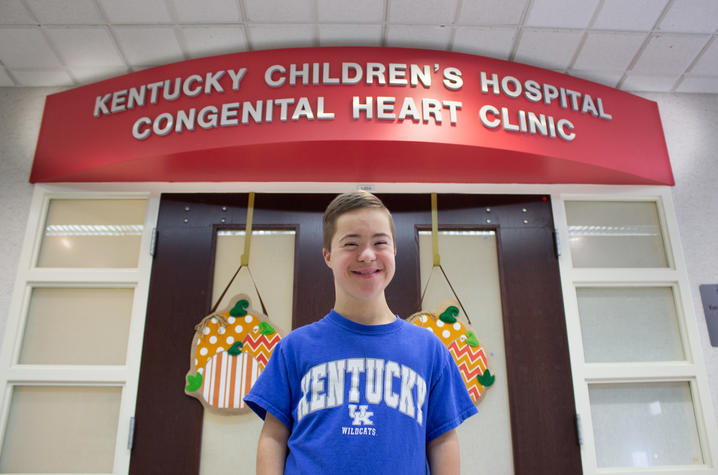After Successful Treatment, KCH Patient's Heart is 'Happy'

LEXINGTON, Ky. (Nov. 5, 2019) – Ask 13-year-old Jeremiah Zurowski how he’s feeling and his one-word reply speaks volumes.
“Happy.”
And he is happy. He talks excitedly about his favorite movies and playing with his brothers. He’s generous with smiles, high-fives and hugs. His heart is big and warm, but until recently, his heart wasn’t healthy.
A ventricular septal defect (VSD) is a hole in the wall that separates the lower chambers of the heart, causing the heart to work harder to pump blood. The defect is common, especially in children with Down syndrome such as Jeremiah. Left untreated, patients with VSDs “fail to thrive,” meaning they don’t grow or develop as they should. Jeremiah was born with two such holes in his heart.
“He was born with two VSDs, a smaller and a larger one, and a leaky valve,” said Jeremiah’s mother Elli. “And we didn't even know about the smaller one until they went in to fix the big one.”
At six months old, Jeremiah had his first open-heart surgery at a hospital in New York. But there were complications – a stitch in the electrical system in Jeremiah’s heart led to an abnormal heart rhythm called complete heart block where electricity could no longer get from the top chambers of his heart down to the bottom chambers to allow it to pump blood effectively. Five days later, Jeremiah underwent a second procedure – the installation of a pacemaker to provide a means to allow electricity to conduct down through his heart and regulate its beat.
But as Jeremiah grew, his pacemaker began to fail. One of the electrical leads that regulates the heartbeat was fraying, so the system had to be replaced. In infants and small children, the veins are so small, the device has to be placed on the outside of the heart. His electrophysiologist opted for a transvenous pacemaker that is typically placed in teenagers and adults.
“One of the limitations of cardiac devices for children is size,”said Dr. Shaun Mohan, pediatric electrophysiologist at the Kentucky Children’s Hospital (KCH) Congenital Heart Clinic. “Putting a pacemaker in a young or small child has risks and we are limited by the size of the patient’s vessels. The veins of a child are much smaller than that of an adult and this can lead to problems down the line if we cannot reliably predict how big a patient will become after puberty. His Down syndrome will lead him to being shorter compared to other people his age, and based on his size and age, I felt it was an appropriate time to implant a transvenous pacemaker.”
In January 2019, Jeremiah received his new pacemaker. His doctors at UK can monitor his heartbeat remotely through a box connected to the Zurowski’s phone line. Whenever Jeremiah is near it, his heartbeat is detected and the information is sent from Jeremiah’s home in Casey County to the heart clinic at UK.
“He will need lifetime follow-up for the pacemaker, which will eventually need to be replaced at some point when the battery drains,” said Dr. Douglas J. Schneider, medical director of the Joint Pediatric Heart Care Program at KCH. Schenider performed a catheterization procedure on Jeremiah in October to assess whether he needed a stent in his pulmonary artery. “His prognosis is good and his heart function is excellent," he said. "Jeremiah is an awesome kid, and we’re honored and blessed to be able to help care for him.”
Jeremiah’s mother is appreciative not only for the surgical care, but for how the staff at KCH and in the pediatric heart clinic interact with Jeremiah.
“The staff [at the clinic] has been excellent and really accommodating us with all the sensory challenges that he deals with,” said Elli. “They've always been very understanding. They never treated him like, oh, something's wrong, or he needs to get over it. We've experienced that in other doctor offices where they don't understand the fears he deals with. But here, they've always assisted him. They've never made him get up on the table because he has a hard time getting up there. So they've always done his exams in the chair. Whatever possible, they’ve adjusted themselves to work around him.”
Jeremiah’s recovery went perfectly, and he’s back to playing to football and Wii games and “gently” wrestling with his brothers. He continues to receive follow up care at KCH, where he loves spending time with his favorite nurses, Megan and Milissa.
“Patients like Jeremiah do well mostly because of strong family supports and having a medical team that works with the family,” said Mohan. “We all work together throughout this lifelong journey to give Jeremiah the best chances at a great quality of life.”
As the state’s flagship, land-grant institution, the University of Kentucky exists to advance the Commonwealth. We do that by preparing the next generation of leaders — placing students at the heart of everything we do — and transforming the lives of Kentuckians through education, research and creative work, service and health care. We pride ourselves on being a catalyst for breakthroughs and a force for healing, a place where ingenuity unfolds. It's all made possible by our people — visionaries, disruptors and pioneers — who make up 200 academic programs, a $476.5 million research and development enterprise and a world-class medical center, all on one campus.




